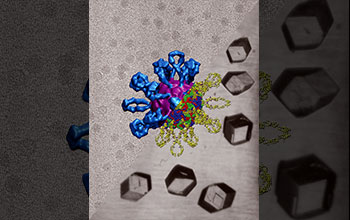Multimedia Gallery
Combined structure of Coxsackievirus A21 and ICAM-1
A composite image showing the combined structure of Coxsackievirus A21 and a receptor molecule called ICAM-1, or intracellular adhesion molecule 1. The virus is one of those known to cause the common cold, and the receptor molecule enables the virus to attach to and infect host cells. ICAM-1, located on the surface of cells, is represented in blue, and the virus is represented in red.
More about this Image
Researchers at Purdue University determined the structure of the virus-molecule complex by combining images taken using X-ray crystallography and cryo-electron microscopy. Being able to determine the combined structure of the virus and ICAM-1 may teaches scientists how the virus recognizes the molecule and how it then anchors to the cell, which represents the initial stages of infection. The virus-molecule complex in the center of this image is a thousandth as wide as a human hair.
This NSF-funded research is aimed at understanding the structures of viruses. (Date of Image: July 12, 2005)
Credit: Image courtesy Purdue University Department of Biological Sciences
Images and other media in the National Science Foundation Multimedia Gallery are available for use in print and electronic material by NSF employees, members of the media, university staff, teachers and the general public. All media in the gallery are intended for personal, educational and nonprofit/non-commercial use only.
Images credited to the National Science Foundation, a federal agency, are in the public domain. The images were created by employees of the United States Government as part of their official duties or prepared by contractors as "works for hire" for NSF. You may freely use NSF-credited images and, at your discretion, credit NSF with a "Courtesy: National Science Foundation" notation.
Additional information about general usage can be found in Conditions.
Also Available:
Download the high-resolution JPG version of the image. (3.9 MB)
Use your mouse to right-click (Mac users may need to Ctrl-click) the link above and choose the option that will save the file or target to your computer.



 All images in this series
All images in this series